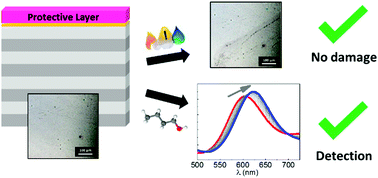Incorporation of porous protective layers as a strategy to improve mechanical stability of Tamm plasmon based detectors†
Abstract
Nanostructures supporting optical modes known as Tamm plasmon-polaritons are a new class of optical devices with promising characteristics for sensing applications. Their synthesis involves the deposition of a thin metallic layer on top of a distributed Bragg reflector. Unfortunately, this metallic layer can be easily detached or scratched during normal handling or under operating conditions. In this work, a new strategy to protect these devices from mechanical stress by adding a porous protective overlayer is presented. Three different mesoporous oxides prepared using a sol–gel process were chosen to cover the device: ZrO2 and Ti–Si mixed oxides functionalized with either vinyl or phenyl groups. The mechanical and tribological properties of each candidate were measured using nanoindentation and its ideal thickness was determined by simulation of the optical response. Finally, the devices were characterized mechanically, to test their stability, and their sensing capabilities were determined for both liquids and vapours. The results indicate that thin mesoporous films used as protective layers provide a clear improvement in the device's resistance towards mechanical stress without compromising the optical and sensing properties. The strategy of protection using a porous top layer presented in this work can be extended to other devices which require interaction with the environment through an exposed unstable surface.

- This article is part of the themed collection: Celebrating materials science in South America


 Please wait while we load your content...
Please wait while we load your content...